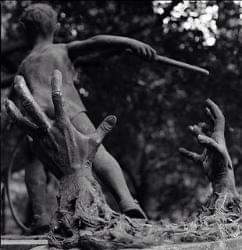Fun facts about Pileated Woodpeckers! And other woodpecker
-Pileated woodpeckers are the largest woodpecker species in North America and generally do not migrate, making them fun to watch all year round.
-Carpenter ants can make up to half of their diet but they also snack on other insects, fruit and nuts.
-Pileated Woodpeckers will mate for life once they find a partner. Males attract females through a series of courtship displays, such as flight displays, head swinging, raising of the crest feathers, and spreading their wings to reveal white patches.
-Nests take more than one month to build and do not get reused the next year, preferring to seek out another tree to excavate a new cavity upon nesting season.
-Both males and females participate in feeding their young. Chicks may remain with the parents for up to three months after hatching.
In this video, you will see a male pileated woodpecker (Dryocopus pileatus) chipping a hole in a large white pine tree within our bear enclosure. Many animals can come and go in and out of the bear enclosure, but not the bears of course. We are lucky enough to have pileated woodpeckers visit the enclosure somewhat often.
They peck large holes in trees in search of their favorite food source, carpenter ants! They will also peck holes for their nests. These nest holes are very important for many other cavity-nesting wildlife. These woodpeckers make homes for a variety of other wildlife by creating cavities in trees while searching for food or creating their own homes.
Other bird species and small mammals rely on these cavities for shelter and nests. Although they may be annoying when found pecking on the sides of your homes, these woodpeckers are especially important for providing other wildlife with shelter. Here are some other cool facts about the pileated woodpecker.
Their tongues are long and tipped with a barb for getting insects out of trees. The tongue is so long that it actaully wraps around the woodepckers brain; this helps it store its long tongue and helps protect its brain while pecking trees.
Males and females are easy to tell apart. Both have a large red crest on the top of their head, but only the male bears a red strip on its cheek. This strip is black on females. In this particular video, it is hard to notice because of the angle of the shot and the lack of stillness from the woodpecker.
These woodpeckers also have really tiny and fine feathers in their noses. Similar to how humans have nose hair, pileated woodpeckers have feathers in their nostrils. Since pecking wood can be quite messy, these hairs help keep debris from entering their nasal passage.
We have live cams posted around the enclosure that can move to follow the bears (and other animals for that matter) around the enclosure. We have awesome volunteer cam drivers that are quick to record the cool things they see on the cams. This video was captured by one of our volunteers, Cindy! Thanks for the capture Cindy.
See Albirda: Put a Bird on It at our Calgary Gallery until April 29, 2023.
"Woodpecker 1," Darcy L. Hoover, 2022, cotton thread on unbleached muslin, 23 x 18 cm. $47
"Woodpecker 2," Darcy L. Hoover, 2022, cotton thread on unbleached muslin, 23 x 18 cm. $47


















Comments
Post a Comment